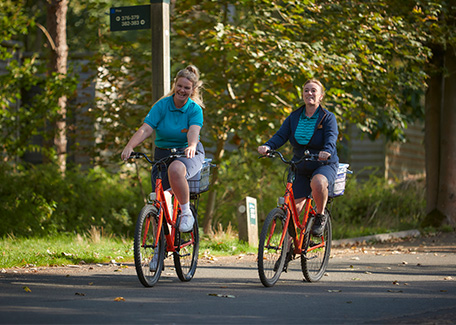Ireland Gender Pay Gap Report 2025
The gender pay gap is the difference in the average hourly wage of all men and women across a workforce. This is different to equal pay, which ensures men and women are paid the same wage for equal or similar work – we always offer equal pay in all of our roles.
At Center Parcs, we are committed to encouraging our staff to grow to their very best and achieve their potential. We know the best way we can do this is to ensure that we treat our staff fairly and encourage progression for all. That’s why we take monitoring our gender pay gap very seriously and are taking action to improve it
The gender pay gap at Center Parcs
The median gender pay gap for Center Parcs Ireland is 8.1% (reduced from 9.8%) and the mean gender pay gap is 11.3% (reduced from 12.8%)¹. We are pleased to see the significant reduction in our gender pay gap over the year but we know we have further to go and are committed to improving this further. For part-time staff our mean hourly pay gap is 6.4% and our median hourly pay gap is 5.4%. For fixed-term staff, our mean hourly pay gap is 12.7% and our median hourly pay gap is 7.8%. We continue to ensure strong female representation at all levels of the business – at Center Parcs Ireland, over 40% of our management team are women, including the role of Deputy Village Director. Our business continues to be major employer of women in the area and we employ more women than men in all of our earning quartiles.
¹ Compared to a mean gender pay gap in Ireland of 9.6% (Central Office for Statistics 2022 data).
Understanding the gender pay gap at Center Parcs
We know that there is a gender pay gap in terms of hourly pay for women.
Beyond having good representation of women in senior roles, demonstrated by more than half of the top two quartiles of earners being female, we do recognise that the gap itself is in part due to men within the business being more likely to hold senior roles.
We are committed to developing our female talent and fostering greater representation of women in senior roles within our business. We actively support and nurture the careers of women through initiatives such as our International Women’s Day celebrations and our ongoing annual Women’s Development Programme. This programme promotes growth and career progression among our wider female talent, focusing on overcoming imposter experiences, navigating career phases, harnessing the power of community, and building a strong personal brand. We also continue to monitor and review our promotion rates by gender and use this data to create actionable plans that drive improvement in this area.
Our steps to reduce the gender pay gap
Some of the actions we are taking this year include:
- Implementing our DE&I strategy across the business, which includes a range of celebrations and sessions designed to raise awareness on topics such as unconscious bias and the power of equity.
- Further developing our DE&I Network, fostering stronger connections and collaboration among our female colleagues – 86% of our DEI network in Ireland are female
- Implementing strategic measures to strengthen inclusivity in our recruitment processes. Most notably, we are working to ensure gender-bias reviews are conducted when producing job descriptions and adverts, so as not to unintentionally exclude prospective female talent.
- Ensuring all colleagues across the organisation complete mandatory DE&I training, enhancing awareness and education on key topics impacting gender equity, such as unconscious bias and gender stereotypes.
- Using transparent pay rates, ensuring that any gender pay gap is driven by representation at different seniority levels rather than by inequities within our pay framework.
- Conducting ongoing reviews of pay differentials at each seniority level to support pay transparency and continuous improvement.
The gender pay gap in numbers
Proportion of men and women per earnings quartile
 Figure 1: Pie chart showing the proportion of men and women per earnings quartile
Figure 1: Pie chart showing the proportion of men and women per earnings quartile
Upper quartile (highest paid)
Men: 48.7%
Women: 51.3%
Upper middle quartile
Men: 44.6%
Women: 55.4%
Lower middle quartile
Men: 30.6%
Women: 69.4%
Lower quartile (lowest paid)
Men: 23.5%
Women: 76.5%
The chart shows the proportion of men and women per earnings quartile for the four quartiles. There is a fairly even split across the upper two quartiles (the highest paid). There are more women than men in the remaining two quartiles, with the highest proportion of women being in the lower quartile (lowest paid), followed by the lower middle quartile.
Bonus pay gap
Our median bonus pay gap is 50.0% and our mean bonus pay gap is 46.4%. This is mainly due to the fact that our bonus is linked to total annual salary. This is a higher figure for full-time employees and we know that men are more likely to work full-time at Center Parcs than women. Benefits in Kind are specific employee benefits for senior managers, such as company cars and private medical care.
Proportion of colleagues receiving a bonus or benefit in kind
 Figure 2: A table showing the proportion of men and women receiving bonus payments and Benefits in Kind
Figure 2: A table showing the proportion of men and women receiving bonus payments and Benefits in Kind
Bonus
Men: 65.3%
Women: 64.1%
Benefits in Kind
Men: 1.3%
Women: 0.3%
The table shows the proportion of men and women receiving bonus payments and Benefits in Kind.



